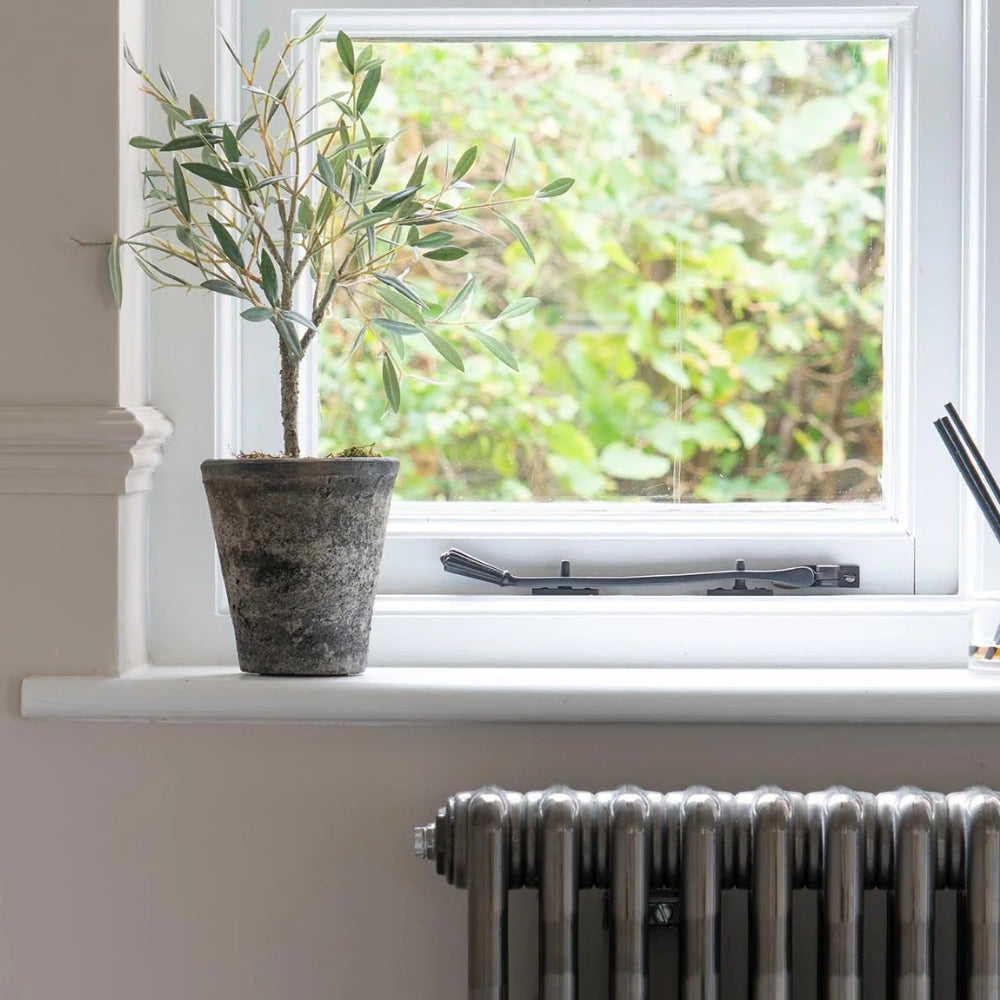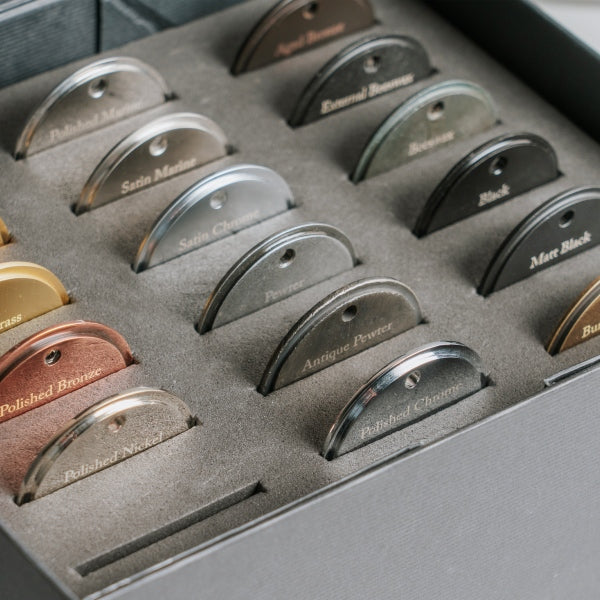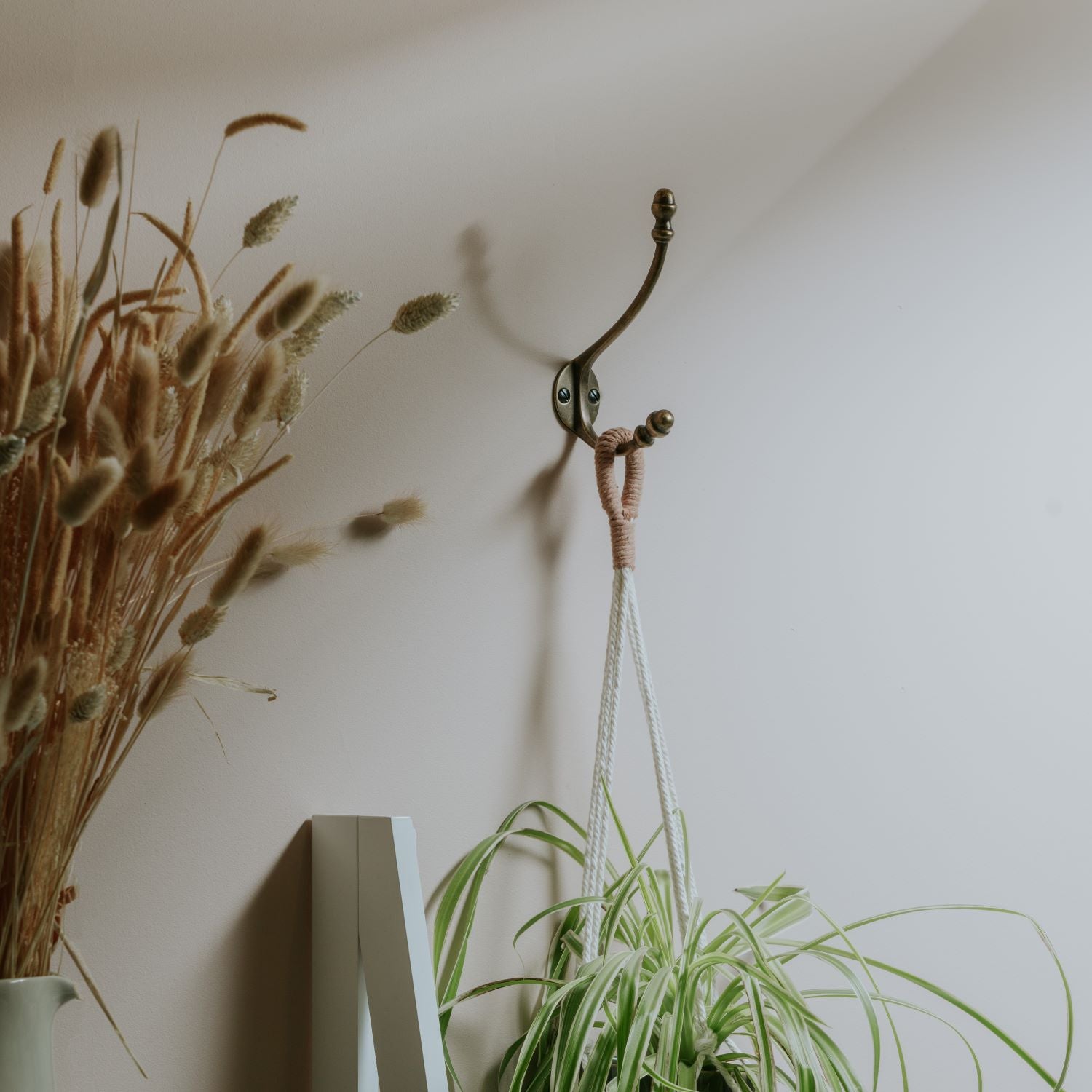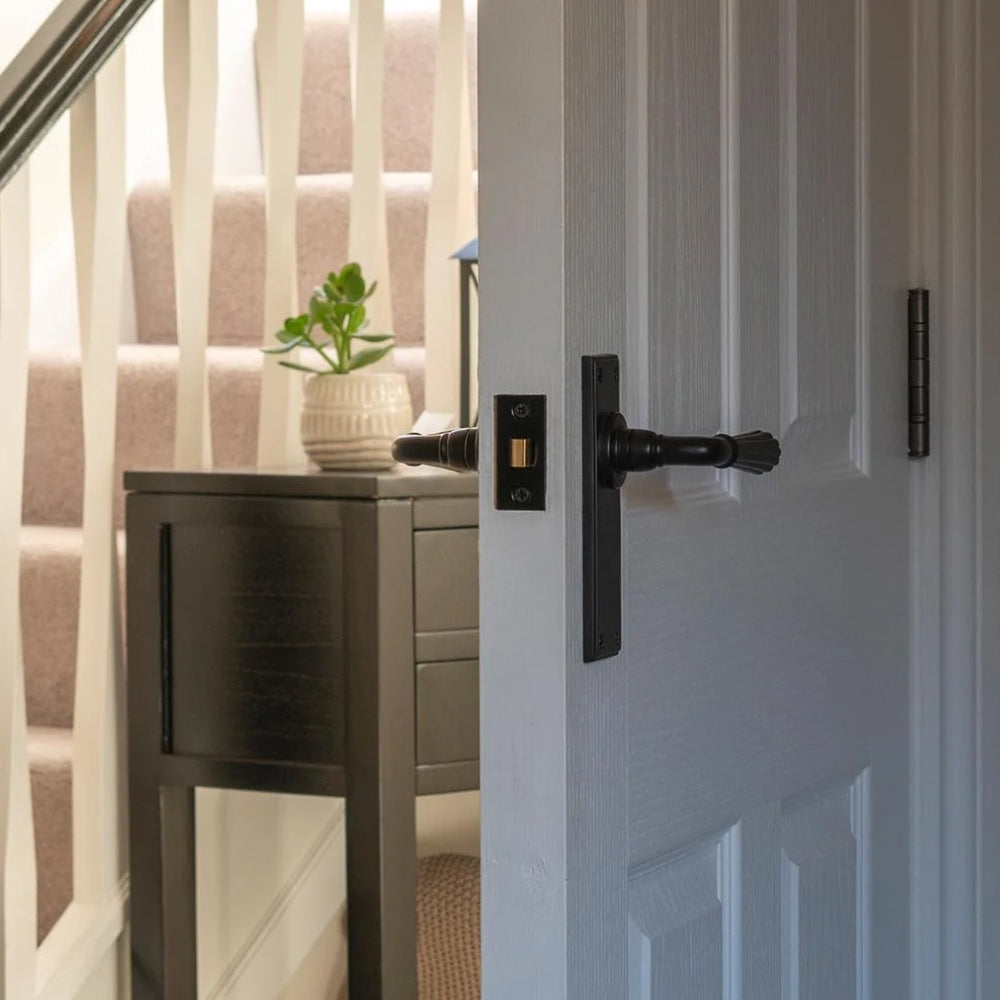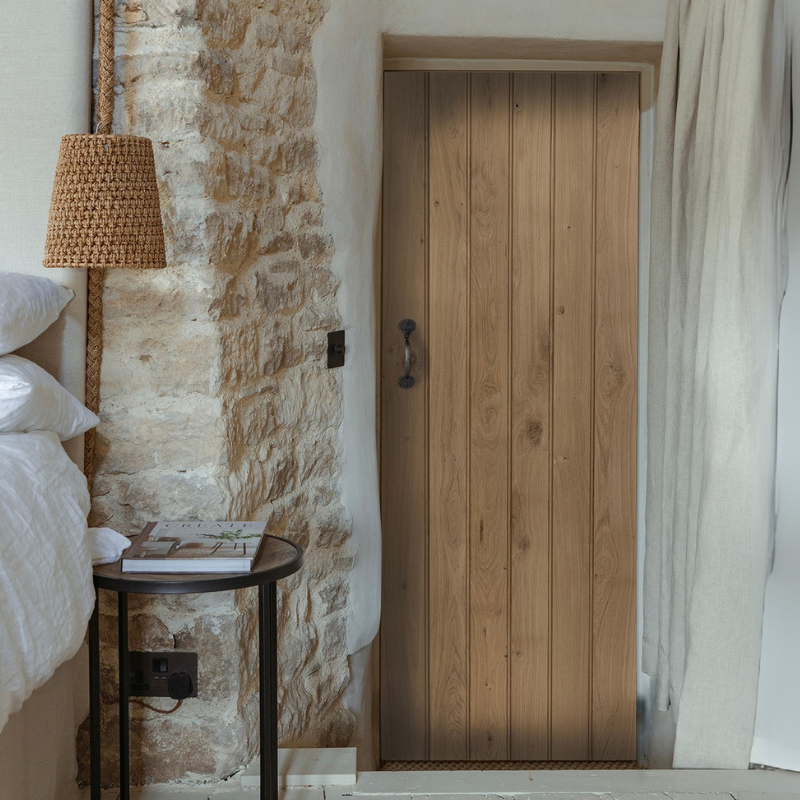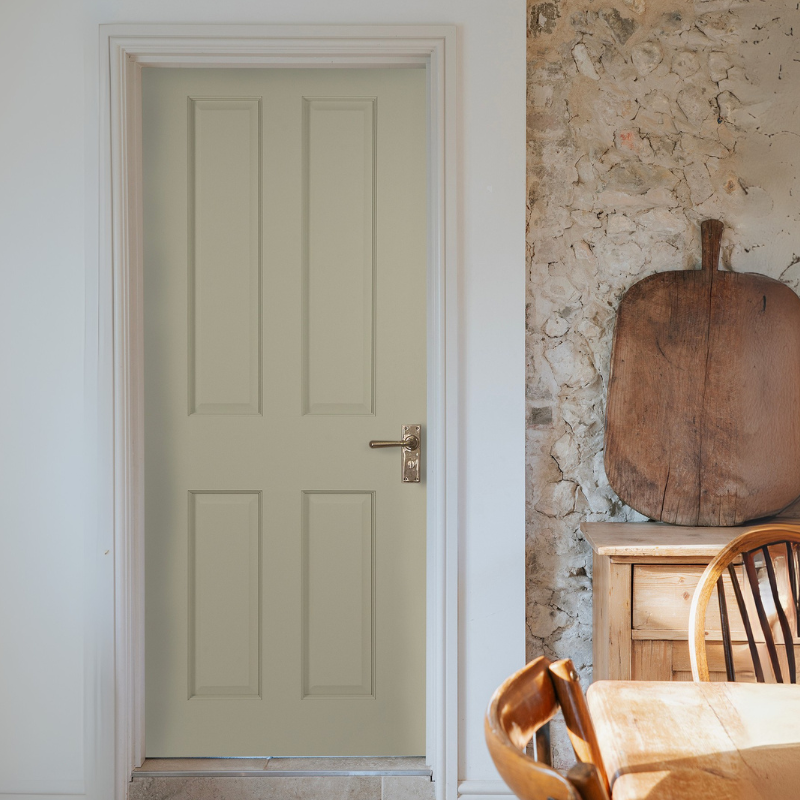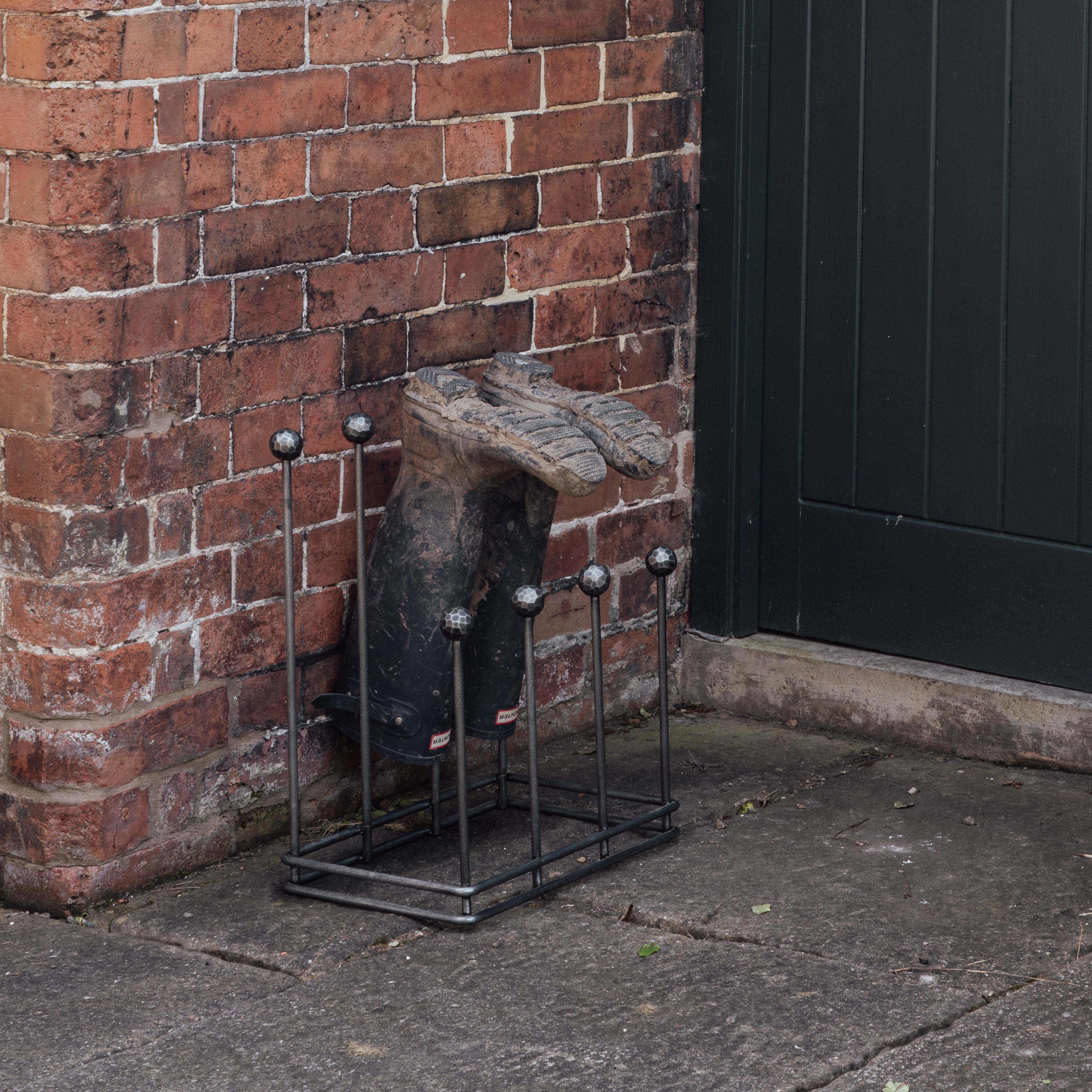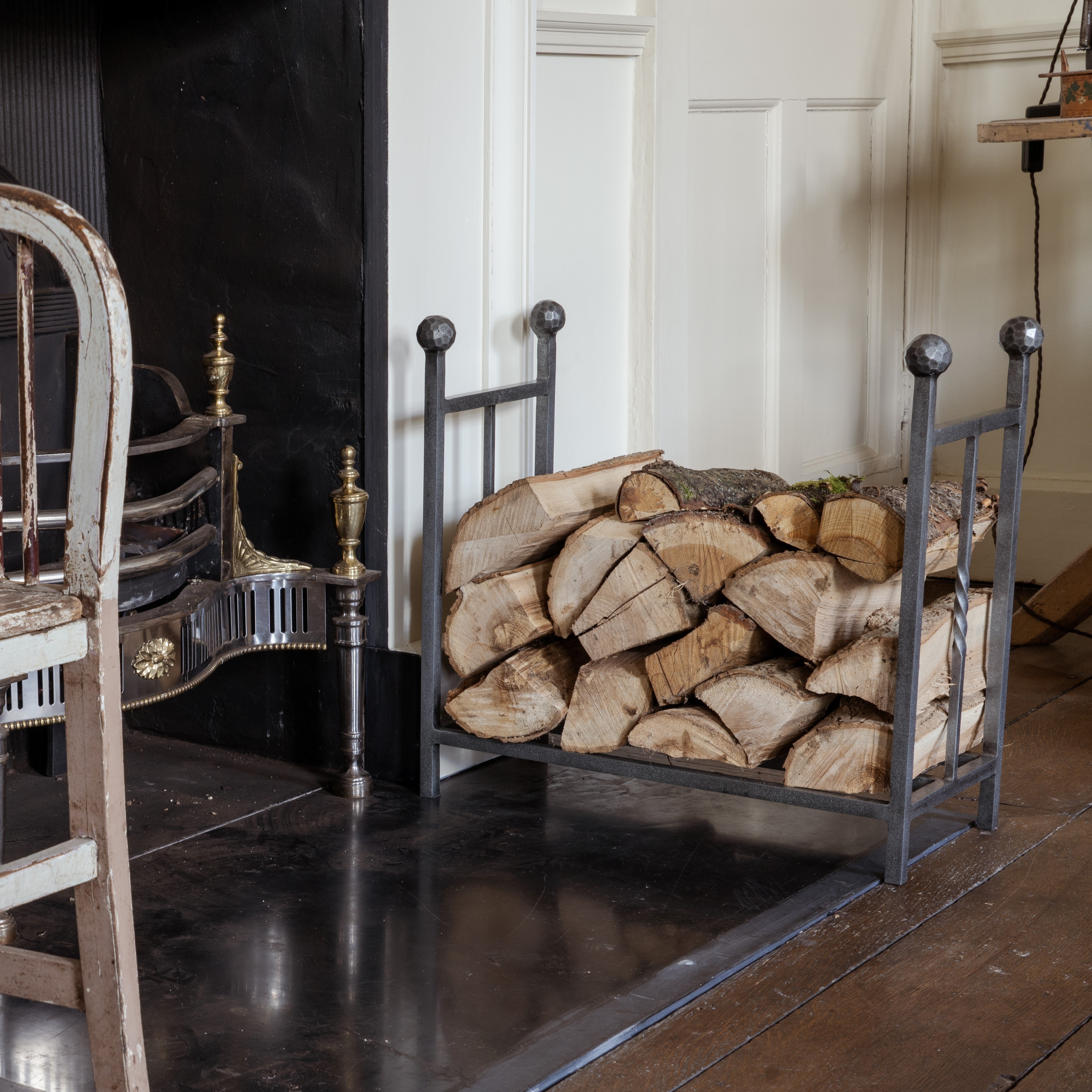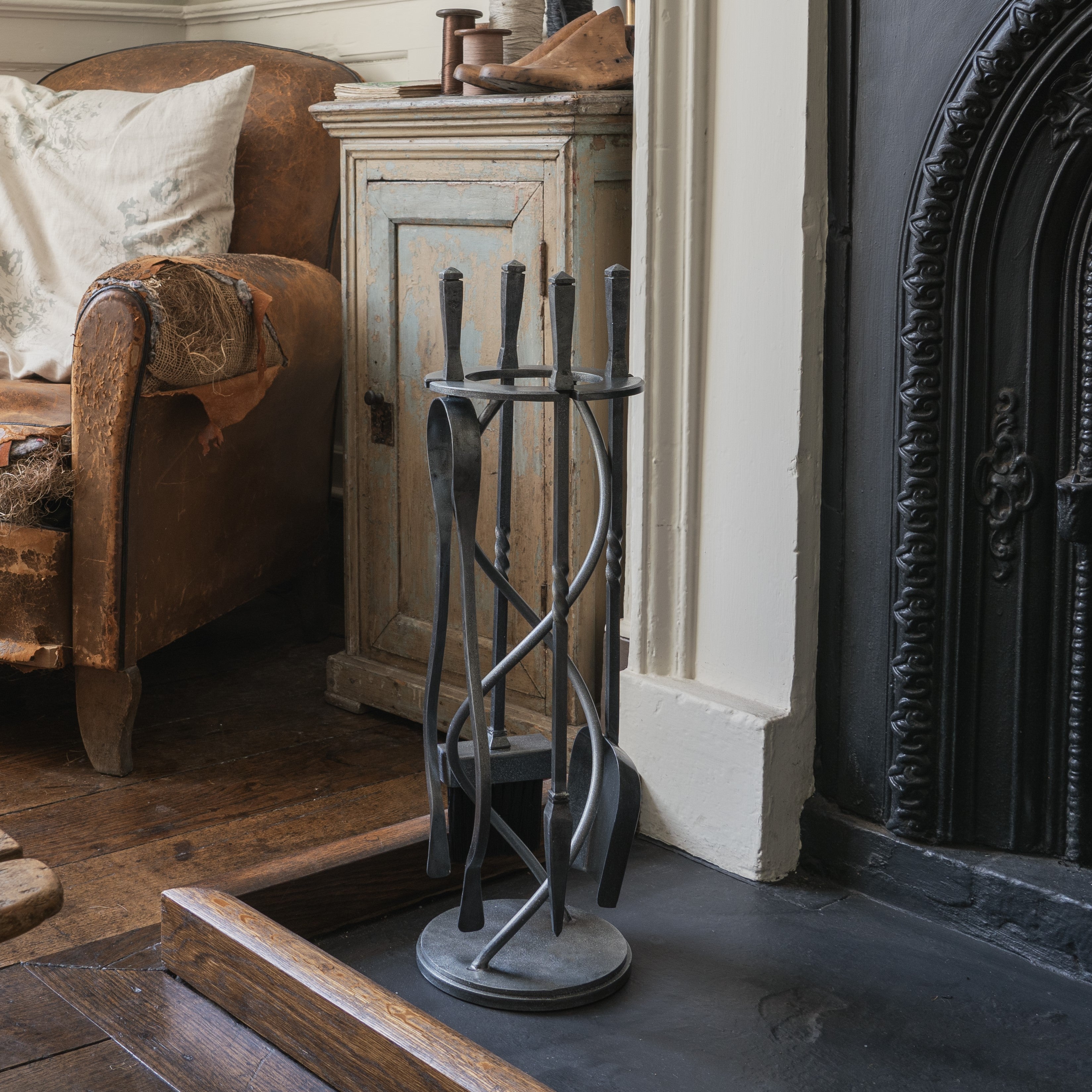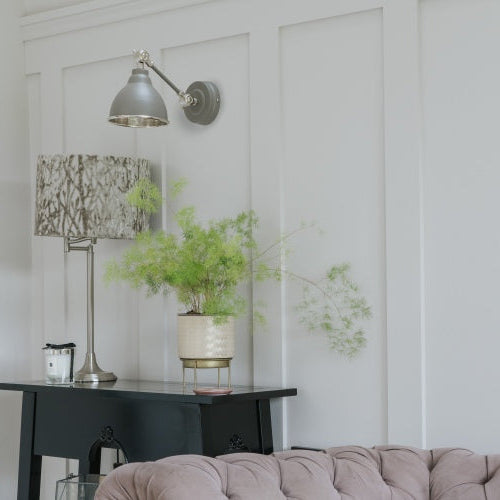FAQs
We work hard to answer as many questions as possible, but if you can't find the information you're looking for, don't panic!
Our team of experts are happy to answer any queries about our products, services, and more. Chat with us now!
General Questions
How can I find the product I’m looking for?
If you know the product code (SKU) of the item you want, then simply enter that code into the search bar (top right corner) of the website and you will be taken straight to the item. If you don’t know the code, then you can use the top menu to choose a specific subcategory of products. You can then use our filter system to narrow down your search and find the exact product you’re looking for.
What brand are your products?
All the goods we sell are genuine, From The Anvil ironmongery so you can trust that you’re receiving durable, high-quality products.
Where can I find more information about a product?
Information about each product, including its dimensions, finish, and technical drawings, is including on its product page. If you can’t find the information you’re looking for, or you’re confused about which product you need, feel free to get in touch and we’ll help answer any questions you may have.
What should I do if my product is missing a part?
If you lose part of your product, don’t worry as we sell replacements in the “Spares & Accessories” section of our website. You can check the technical drawing of your product to see exactly which replacement part you’ll need.
If your product is missing a piece upon delivery, please contact us as soon as possible and we’ll do our best to resolve the issue.
Do you offer samples?
We can supply samples on request. Please note that our general policy is to charge for the product on a sale or return basis, but delivery will be free. Please contact us to find out more.
Shipping
Do you ship internationally?
We’re happy to deliver internationally, but shipping costs and timings can vary by country. We recommend getting in touch to discuss any delivery requirements outside of the UK Mainland.
Also, please keep in mind that international orders may be subject to customs charges. Hand Forged is not responsible for handling customs charges; this is entirely the responsibility of the customer.
How much does delivery cost?
Free delivery applies to all orders over £60.00 (net value) within the UK Mainland*. UK Mainland orders under £60.00 are charged £5.40 carriage. Delivery to orders outside of the UK Mainland can be arranged, but carriage will vary depending on location. Please get in touch to arrange overseas delivery.
How long will my order take to arrive?
For the UK Mainland*, we aim to deliver your order within 48 working hours via next day courier service (i.e. DPD). Orders placed late Friday or over the weekend will be processed on Monday. If for any reason there is a delay, we will keep you up to date with expected delivery times. Goods will require a signature at the delivery address upon arrival (we aim to delivery between 8am and 3pm).
What if there's no delivery option available for my address?
If no shipping option is shown for your address, please contact a member of our team to discuss delivering your order. We'll do our best to accomodate delivery wherever possible.
Returns
How can I cancel my order?
To cancel your order, you’ll need to contact Customer Services via phone (0845 459 8495) or email (info@handforged.co.uk) who will issue you a returns note. If your order hasn’t yet been sent, no fees will be incurred. If you cancel your order after it’s been shipped, you’ll be charged a carriage fee of £10 plus VAT to cover our administration and restocking costs. The same fee is incurred if goods are returned to us as undelivered.
How do I return an item?
You can request a return by logging into your Hand Forged account and selecting the order you'd like to return.
A member of our team will review your request. If accepted, you'll be sent an email containing a link to a Returns Note which you must print, fill out, and include in your returned package. This email will also include a Returns Label which you must print off and stick clearly to the outside of your package (make sure to cover any existing labels).
You must drop your parcel off within 7 days of receiving your Returns Label.
Upon receiving and inspecting your returned package, we will credit your refund to your original payment method. Funds should arrive within 30 days at the latest.
Where can I find a Returns Note?
You should receive a link to a Returns Note within the email approving your return.
Alternatively, you can find a Returns Note here.
How should I package my return?
We kindly ask that you return your order in its original packaging where possible.
Make sure to include your completed returns note inside your package.
Ensure all products are wrapped carefully to avoid damage during transit. If goods are poorly packaged and damaged during transit, sum of your funds may be witheld to cover the cost of the damage.
Ensure that your returns label is stuck securely to the outside of your package and can be read clearly. Cover any existing shipping labels.
How do I send my return?
We will send you a tracking label via email for you to attach to the outside of your parcel.
Once packaged, you can drop your return parcel off at your local post office. Or, arrange for it to be collected by your local courier.
If you'd like to arrange your own return postage, or drop your return off in person, Get in Touch with us.
Whats the return address?
Please address any returned parcels to: 33 Ddole Road Enterprise Park, Llandrindod Wells, LD1 6DF, United Kingdom.
How long do I have to return an item?
You may return goods up to 6 months from the date of purchase.
Goods returned to us within 2 months of invoice date will be credited with no restocking fee.
Goods returned within 2-6 months of invoice date will incur a 15% restocking fee.
Under no circumstances will we accept returns after 6 months from date of purchase.
Are there any products I can't return?
We cannot accept returns for bespoke or made-to-order products. This includes all wall, ceiling, and cluster pendant lights.
We are also unable to accept returns for items beyond 6 months of purchase.
Can I return an order from outside of the UK?
Yes, of course you can! However, international returns can be more complex and costly due to Duties or Taxes that may be added across-border. If you'd like to make an international return, please Contact Us to discuss.
How much do returns cost?
When returning an item, we'll send you a pre-paid shipping label to post your order.
The cost of this shipping will be deducted from your total refund amount and will depend on the size/weight of your order.
If you're returning your products because they're damaged, faulty, or have been delivered incorrectly, then we will cover the cost of shipping ourselves.
What should I do if my products are damaged/faulty/incorrect?
Upon receiving your delivery, if your items are deemed unsuitable for your purpose, you are under a legal duty to take care of the products and to not use them. The goods must be returned in the same condition they were received in, with the original undamaged packaging and paperwork. For returns/replacements, please contact our the Hand Forged Customer Services Team either via telephone (0845 459 8495) or email (info@handforged.co.uk) who will allocate you a returns number and returns note via email. We will refund the full order amount, including delivery costs, as soon as possible upon receiving a cancellation notice, within 60 days at the latest.
If the returned goods have been used or installation has been attempted after having a reasonable chance to inspect them, you’ll be in breach of your legal duty to take care of the products for which we may recover appropriate sums.
Under no circumstances will we accept returns after 6 months from date of purchase.
Finishes and Care
What finishes do you offer?
We currently of 22 distinctive finishes, each with unique properties, appearances, and base materials. For detailed information about each finish, please visit the “Finishes” section of our website.
Which products can I use externally?
When cared for properly, most of our finishes are suitable for external use. You can find the care & maintenance required for each unique finish in the “Finishes” section of our website.
However, we strongly advise against using our Beeswax products outdoors as the wax coating protecting the finish is easily worn away in adverse weather conditions and could cause the metal to rust if left untreated. If you do want to use Beeswax products outside, we recommend opting for our External Beeswax finish, which looks the same but is made with anti-corrosive beeswax which will better preserve the products.
We also do not recommend using Natural Smooth or Natural Textured hardware externally.
Are your products suitable for coastal areas?
Our Satin Marine SS and Polished Marine SS products are forged from grade 316 stainless steel and have strong anti-corrosive properties which make them suitable for use in coastal areas.
Unlacquered brass hardware (including Aged and Polished Brass) can be used in coastal regions, but please be aware that the high salinity will accelerate the tarnishing process, so regular cleaning is advised to discourage any green oxidation that occurs.
We don’t recommend using any other finishes in coastal areas as the high atmospheric salinity will cause them to rust over time.
Can I fit ironmongery in a room immediately after decorating?
We advise against this, as the moisture in newly plastered/painted rooms can cause surface rust to appear on the ironmongery. Ideally, you should wait at least 2 hours, or until all surfaces are completely dry, before fitting your ironmongery.
Why are there white marks on my Beeswax products?
Due to changes in temperature, our Beeswax products can sometimes develop a white bloom which you may see when opening the packaging. Don’t worry, as this is natural and can be easily removed by gently buffing the surface of the product with a soft cloth.
How can I maintain the finish of my product?
For any product used externally, we recommend periodically oiling moving parts with our 3-in-1 oil to keep the mechanics working smoothly.
For many of our finishes, we suggest occasionally wiping the surface with a lightly oiled cloth and avoiding the use of any chemicals as these may damage
the finish.
The exact care guide for each finish can be found in the “Finishes” section of our website, or on each individual product page.
When do I need to use maintenance wax?
Maintenance wax adds an extra layer of protection to our Beeswax products. When Beeswax products are used in damp or humid environments, such as bathrooms or kitchens, a layer of rust can sometimes develop on their surface. If this occurs, gently rub the surface with wire wool and apply a layer of maintenance wax with a rag or brush. We recommend occasionally re-coating your Beeswax items with a layer of maintenance wax.
Are your products lacquered?
Most of our products are unlacquered to give an authentic, living finish that ages over time to create a beautiful tarnish (although you can reverse this process using our Brasso polish).
We avoid lacquer when possible because over time it can wear away if not properly cared for.
Our Pewter, Polished Bronze, Satin Brass, and Burnished Brass finishes all have a thin layer of clear lacquer used to protect the finish. Our Aged Bronze products are coated in an applied colour lacquer finish which is extremely hard wearing.
Will my Aged/Polished Brass products tarnish? Can I prevent or accelerate this process?
From The Anvil's Aged and Polished Brass finishes will indeed tarnish over time (but don't mistake these changes for corrosion!). The more residue, pollution, or salt that is in the air, the quicker your brass will tarnish and dull down. You can easily restore the bright shine of your brass by gently buffing with a soft cloth and some Brasso. Alternatively, leave your brass products to tarnish naturally, allowing them to develop a dark and beautiful patina.
So, although your brass may dull down over time, you can be confident that you can restore it's bright shine quickly and easily with a little bit of Brasso. When properly cared for, your brass hardware will last a lifetime.
What base metals are your products made from?
For the majority of our hardware, the base metals are as follows:
- Black, Beeswax & Pewter: Mild steel
- Polished Brass, Aged Brass, Satin Brass, Burnished Brass, Nickel & Chrome Solid brass
- Polished Bronze & Aged Bronze = Solid bronze
- Satin & Polished Marine Stainless Steel = Grade 316 marine stainless steel
Base materials may be different for other product ranges, such as sinks and lighting.
Door Hardware
What type of door handle do I need?
This depends on which type of door and lock/latch you choose.
Lever lock handles are used in conjunction with a 5 lever mortice lock, usually on exterior doors that require locking (i.e. front/back doors).
Lever latch handles are used in conjunction with mortice latches, usually on interior doors which don’t require locking (i.e. living room doors).
Lever bathroom sets are used in conjunction with a bathroom mortice lock which can be locked via a thumbturn on the inside and opened from the outside with a coin during an emergency (e.g. bathroom doors).
Lever Euro handles are used in conjunction with Euro cylinders and Euro sash locks, usually on exterior doors (e.g. patio/conservatory doors).
Espagnolette lever handles are used in conjunction with multi point locks and Euro cylinders on sliding/bi-folding door sets and modern front doors which use these locking systems.
All lever handles have a measurement called the “centre” which refers to the distance between the centre of the door handle and the centre of the keyhole. This distance dictates which type of lock is needed. All our lever handles have standard centre measurements to fit all standard British locks/latches.
What should I do if my lever handle won’t return to its horizontal position?
When this happens, it usually means that you have an unsprung handle, and that the spring in the existing lock/latch isn’t strong enough to return the lever handle to its horizontal position. There are several ways you can fix this issue. Firstly, you could replace your unsprung handle with a sprung version which contains a strong spring within its backplate. Secondly, you could purchase a Heavy-Duty lock/latch which should be strong enough to return the lever handle to its original position. If this is still insufficient, you can retrofit a spring unit cassette behind your door handle/knob where it goes over the spindle to help strengthen the existing spring in the lock/latch.
What is an Espag. door handle?
Espag. is short for Espagnolette, a French word used to describe a type of lock mechanism. Originally, this style of lock was fitted onto the vertical frame of a pair of French doors. It consisted of a long, metal rod which had hooks at the top and bottom, linked to a turning handle. This was also used on casement windows (but we now refer to this as a Cremone bolt in our range).
In modern decades, this lock was modified to be fitted within the door or window frame. Similar to multipoint door locks, espag. window locks are deemed to offer better security due to the multiple locking points along the frame. This type of window lock is found on most modern built homes, especially those with double glazing. These locks can be fitted to uPVC or wooden casement windows or French doors.
What’s the difference between sprung and unsprung handles?
All locks and latches contain a spring which helps return the lever handle to its horizontal resting position after use. ‘Sprung’ handles have an additional spring incorporated into their rose or backplate to aid this process – this is especially important for weighty handles which may be too heavy to return without it. ‘Unsprung’ handles do not contain this spring and are often used with a multi-point lock with which the handle must turn in two directions (upwards to lock the door and downwards to operate the latch).
Most of the From The Anvil handles we sell are sprung, but there are a few exceptions. Make sure you read the description on the product page to ensure you choose the correct product for your needs.
Why are some door handles handed? Which do I need?
Many of our handles are left- or right-handed. This affects how the handle interacts with the locking mechanism. To determine which hand you need, stand on the side of your door where it closes towards you. If the hinges are on the right side, you’ll need a right-handed handle (or left-handed if they're on the left side). Some handles aren't handed e.g. pull handles because they operate independently to the lock. These are suitable for both left & right-hinged doors.
Are your door knobs sprung or unsprung?
All our mortice knobs are unsprung because they’re usually used alongside a latch and having a spring in both the door knob and the latch can make the mechanism stiff and hard to use.Because our knobs are unsprung, we recommend only using Heavy-Duty latches with them.
Can I use your door handles/knobs with an extra thick door?
Yes, you can, but you may need to purchase a longer spindle (the metal bar that passes through the door) to ensure it can reach through the full thickness of your door. These are available in the “Spares & Accessories” section of our website.
How can I fit a door knob to one side of a door without it turning (e.g., for a wardrobe or cupboard door?)
To fit a door knob to one side of a door, you’ll want to use a Threaded Taylor’s Spindle which prevents the knob turning and allows it to operate as a static pull. You can find these in the “Spares & Accessories” section of our website.
Can I use a centre door knob as a functional door handle?
In theory, yes. However, we don't recommend it.
Our centre door knobs are quite large and heavy, which would put a strain on even the heaviest-duty latch. Also, our centre door knobs are not supplied with a grub screw to locate and lock the spindle into position.
If you're looking for a bespoke product, get in touch with our talented team who can help create the product you want.
What should I do if the thumbturn on my bathroom handle is on the wrong side of the door/my handle faces the wrong way?
All our bathroom lever handles have a fixed thumbturn. This means that for some bathrooms, the handle will be pointing in the wrong direction when positioning the thumbturn on the inside of the door. Don’t worry, as this can easily be changed by finding the washer/Circlip on the back of one of the handles and using a pair of Circlip pliers to remove it. At this point, you should be able to turn the lever to your desired position and return the washer. If you’re still confused, please get in touch with us and we’ll do our best to help you.
Which type of lock/latch do I need?
This depends on where you’ll be using it.
Bathroom mortice locks are operated via a thumbturn on a bathroom lever handle (or with a door knob set and a separate thumbturn) and can be opened via a coin from the outside in case of an emergency.
Euro cylinders are common in newbuilds and are often used with a Euro sash lock (mostly on patio/conservatory doors) or with multi-point locks (mostly on modern front doors).
Mortice latches are usually used for internal doors which don’t require locking.
5 lever sash locks are the most secure option and are recommended for exterior doors.
Locks/latches are also either Standard or Heavy Duty, which refers to the strength of the spring inside. Standard variants are used for sprung handles, whereas Heavy Duty is recommended for unsprung, or particularly heavy, handles which need help returning to their original horizontal position.
What size backset lock/latch do I need?
The most important measurement when choosing a lock/latch is the ‘backset’, which is the distance from the centre of the door knob/handle (the spindle) in relation to the edge of the door.
For example, a 2.5” lock with a 64mm case measurement usually has a backset of 44mm, which means that the centre of the door knob will be 44mm from the edge of the door.
A 77mm case measurement usually has a 56mm backset. The backset determines where your door knob will sit on the door (i.e. where the spindle goes through). When using a door knob, we recommend using a lock/latch that’s 3” or bigger to ensure the knob is an appropriate distance from the edge of the door and that you don’t catch your knuckles when opening it.
What is a privacy latch?
A privacy latch allows you to open a door from only one side. For example, if you have thumblatches on your interior doors, you may want your cupboards to have matching handles. Privacy latches allow you to open the cupboard door from the outside, with the same appearance of a traditional latch but without a latch on the inside.
Can I lock a thumblatch?
Yes, of course. Simply replace your existing staple pin/screw-on-staple pin with a locking staple pin/screw-on-staple pin. This locking version comes with a metal pin attached via a leather strap and can be used to hold the door in place. You can find locking staple pins/screw-on-staple pins in the “Spares & Accessories” section of our website.
How do thumblatches work?
The handle/thumb bar is fitted to one side of the door and allows the user to depress the thumblatch. The thumb piece (or thumb bar) passes through the door and lifts the latch bar off the keep. The latch bar is the horizontal bar which is fitted to the other side of the door and is loosely screw fixed at one end to allow upward movement of the thumb bar. This means the latch bar can be lifted off the keep from either side of the door.
Staple pins and/or screw-on-staples are used to restrict the movement of the horizontal latch bar. Either can be used for this purpose.
The frame keep pin is driven into the door frame and screw fixed for safety and used to hold the door/thumblatch closed.
What type of hinge do I need for my door?
Most modern doors are solid and at least 44m thick, so our standard or ball bearing butt hinges are suitable to use.
Ledge & brace doors are too thin for these hinges, so we recommend using T hinges or strap hinges which accentuate the traditional look of these doors.
H and HL hinges are suitable for all types of door styles and sizes, with HL hinges providing additional strength for extra heavy or damaged doors & shutters.
Parliament hinges can be used to project the door away from its frame upon opening, and Butterfly hinges have an ornate appearance which can be used to add visual interest to a space.
Stormproof hinges are used to give a tight, weatherproof close for external windows.
Friction hinges are suitable for most windows and help hold them in an open or closed position.
You can learn more about a certain type of hinge by reading its product page, but if you’re still unsure about which type you need, feel free to get in touch!
How many hinges do I need for my door?
This mostly depends on the weight of your door. Normally, a single pair (2 hinges in total) will suffice, but if your door is particularly heavy, such as a solid oak door, you can add half a pair of hinges (3 hinges in total) to help support the extra weight. This is true for all hinge types, including butt hinges and T hinges.
If you’re replacing your door, or having a new one fitted, you should talk to your carpenter about how many hinges you’ll need. If you’re still unsure, please contact us for help!
What size hinges do I need for my door?
When fitting an exterior door, or a particularly heavy interior door, we would always recommend at least 4” butt hinges. If the door is likely to get a lot of use over the years, 4” ball bearing butt hinges would be more suitable as their internal mechanisms are more hardwearing.
For ledge & brace doors, the strap part of the T hinge would traditionally reach two thirds of the way across the door width, but our T hinges are exceptionally strong, so as long as they reach at least halfway across the door, they should be able to support its weight.
However, there are some instances, such as a particularly heavy timber door, where you may require a longer T hinge, or may need to add an additional hinge for support (3 hinges in total).
Do hinges come in pairs?
All our hinges are sold in pairs and with the necessary number of fixing screws.
Unfortunately, we’re unable to split pairs of hinges in half as it creates issues with our stock levels.
Do hinges come with screws?
Yes, all of our hinges are supplied with the required number of screws in a matching finish.
Are your hinges fire rated or weight tested?
Our 3" and 4" hinges carry several certifications including the following:
- UKCA (UK Conformity Assessed) - this is the British counterpart of the European Union's CE marking which is applicable to the UK laws and market.
- The Certifier-rated fire door hinges are Grade 13 rated unfer BS EN 1935, meaning they're tested to 200,000 cycles and can hold doors up to 120kg in weight. The stainless-steel hinges have twin ball bearings for a smooth and consistent operation.
- A fire safety certificate, often referred to as a Fire Certificate or BS 5839-1: Fire Detection and Alarm Systems for Buildings in the UK, provides evidence that these measures have been put in place and meet legal requirements.
What type of thumblatch do I need for my door?
Firstly, you’ll need to measure the thickness of your door.
Our Medium thumblatches work with doors up to a thickness of 55mm, and our XL versions are suitable for doors up to 75mm thick, due to the length of their thumb bar.
Once you’ve figured out what size you need, you can choose the finish and style. Our Bean thumblatches are designed to match our Penny End T hinges, and our Gothic thumblatches are designed to match out Arrow Head T hinges.
What’s the difference between surface fixing and bolt-through fixing door knockers?
Surface fixed door knockers are screw fixed to the exterior surface of your door.
Bolt-through door knockers are fitted through the entire thickness of your door, meaning you would need to drill a hole all the way through.
Either type of door knocker is suitable for solid wood doors, but for other types of doors (uPVC, composite, etc.) it’s best to check which type is more suitable.
What type of door bolt do I need?
The most common types of bolts have either a Cranked or Straight barrel. Cranked bolts are fitted to the push side of an outward opening door where they fit into a flat receiver plate, whereas Straight bolts are fitted to the pull side of an inward opening door where they shoot into a receiver bridge. Some of the bolts we stock are Universal, meaning they’re sold with multiple different keep types which can be used on both inward and outward opening doors.
We also offer Flush/Slide bolts, which are mostly used on sliding or bi-folding doors. They’re fitted flush to the edge or face of the door to create a non-obstructive locking mechanism.
What type of spindle do I need?
Any of our products that require a spindle are sold with the correct one, but there may be times when you require a spare or replacement. Luckily, we have these available to purchase separately! Threaded spindles are designed for use with mortice/rim knob sets and come in various lengths and sizes, so make sure you check what your knob set needs before purchasing! Split spindles are used with all types of lever handles. We also offer Taylor’s spindles which can either be threaded or non-threaded and are used for surface-fix ironmongery for use as a decorative pull handle (thereby removing its turning function). This is useful on cupboard and wardrobe doors.
Can I buy 1 handle with a keyhole and 1 handle with a blank back plate as a set?
Yes. We can make these sets bespokely for you if it's something we don't carry in stock or if you're ordering a large quantity of handles.
Alternatively, if it's just for one or two sets of handles, we can actually split a couple of standard handle sets and pair them together to meet your needs. We try not to advertise this too much as it leaves us with piles of half-sets in stock.
Window Hardware
What type of window handle do I need?
This depends on various factors. Firstly, do you want your window handle to lock? If yes, you’ll need a locking fastener, and if not, you’ll need a non-locking fastener.
If your window already has a locking system (as is very common with PVC windows), you’ll require an espagnolette (espag.) handle.
Next, you’ll have to decide if your window requires ventilation. If so, you’ll need to choose a night-venting handle.
Finally, you can choose the style and finish you desire! If you’re still unsure about what type of handle you need, feel free to get in touch!
How do window fasteners work?
Both our locking and non-locking fasteners work via a small grub screw within the handle which is tightened into the fixing plate of the handle using an Allen key.
Do I need a left- or right-handed window handle?
Take a look at your window while standing inside the house. If your handle opens clockwise away from the frame, you need a left-handed variant, and if your handle opens anti-clockwise away from the frame, you need a right-handed handle.
What’s the difference between normal and Night-Venting fasteners?
Normal fasteners allow the window to be locked in an open or closed position and are often used in conjunction with an ‘arm’ stay fixed to the lower frame which allows you to prop the window open without adding any security. Night-venting
fasteners have a pin which protrudes away from the window frame and allows you to lock the window in a slightly open position, so the room can be ventilated without compromising security.
Can I use a fastener on a weather sealed/stripped window?
Yes, you can! When used with the flat mortice plates supplied with them, our fasteners are designed to close onto weather sealed/stripped windows to give a nice, tight fit without damaging the seals.
Is a locking fastener enough security to satisfy my insurance company?
The mechanism within our locking fasteners should be secure enough to withstand any attacks on your home, but you’ll need to talk to your insurance company for the full details of your policy.
What type of window lock do I need?
The simplest type of window lock is a stand-alone lock which is morticed into the window alongside a keep fitted into the frame. You could then fit an espag. handle to operate this lock. Alternatively, a multi-point locking system could be fitted which provides extra security in line with British Standard & insurance policies, but this process is a lot more complex so we advise asking an experienced window fitter or joiner to do this.
What does the 8”, 10”, and 12” measurement of your window stays refer to?
The 8”/10”/12” figure assigned to our window stays is usually measured from the fixing plate to the end of the stay. If you need more information about the exact measurement of these items, it’s best to check the technical drawings and dimensions on the individual product page. Also, please note that the majority of our stays are hand-crafted so there may be slight differences with the actual measurements.
Are your window stays lockable?
Yes, our stays can be locked. To do so, you’ll need to purchase a Locking Stay Pin from the “Spares & Accessories” section of our website. You can use this to replace the existing pin and it can then be locked and unlocked using an Allen key.
Is a stay with a locking pin secure enough to satisfy my insurance company?
The mechanism within our locking stays should be secure enough to withstand any attacks on your home, but you’ll need to talk to your insurance company for the full details of your policy.
What’s a window espagnolette handle and how is it different from a fastener?
Fasteners work simply via a catch and release mechanism via a mortice plate on the edge of the window frame. Espag. handles are designed to operate an espag. lock which is fitted inside the window frame. Espag. locks are a secure shoot bolt system which operate when the espag. handle is turned, moving the spindle to work the lock. These handles are equipped with a long spindle which can be cut down to the desired length but come in a standard diameter to ensure they’re compatible with standard lock types. It’s important to note that our espag. lever handles are handed so you’ll need to ensure you choose the correct hand. All our espag. handles also come with a locking grub screw underneath the handle which can be locked into place with an Allen key for additional security.
Do I need a left- or right-handed espagnolette window handle?
To determine which variant of espag. window handle you need, take a look at your window from inside the property. If your handle opens clockwise away from the frame, you need a left-handed variant. If your handle opens anti-clockwise away from the frame, you need a right-handed variant.
Can I use an espag. window handle on any window type?
Our espag. handles are designed to fit any standardised locking systems (i.e., those with standardised fixing centres and spindle sizes) including stand-alone and multi-point lock sets. As long as the window lock is designed for espagnolette handles, it should work on any window material, including timber, plastic, and aluminium.
What hardware do I need for my sash windows?
Within your window frame, you'll need sash pulleys and a nylon sash cord which helps slide one window over the other when opening.
You'll need to fit each sash panel with sash lifts, eye lifts, or pull handles. All of these are used as handles to open/close the sashes, but vary in their shape and appearance. Typically, two handles are fitted to the upper and lower sash panel frames.
You'll also need one or two sash fasteners, which are fitted on the frame between the two sash windows and used to lock/unlock them in place.
What type of hinges do I need for my windows?
This depends on the type of window you have.
Butt hinges: very common hinges which can be used for standard windows.
Half butterfly hinges: used as a decorative alternative to butt hinges.
Friction hinges: allows the window to be held open at any desired position without needing additional hardware (e.g. a stay).
H & HL hinges: used to provide extra support to large/heavy windows.
Stormproof hinges: used for rebated windows and offers a weather-proof system.
Shutter hinges: used to fit window shutters.
If you're unsure about which type of window hinges you need, talk to a local professional, or get in touch with our friendly team for some free advice and guidance.
Cabinet Hardware
What type of cabinet handles do I need?
This depends on the size and type of cabinets you have and the aesthetic you're hoping to achieve.
For standard cabinets, we recommend cabinet knobs, most of which we offer in small, medium, and large sizes to suit all cabinet doors. For modern and contemporary interiors, T bars are another excellent choice.
For large doors, like fridges or pantries, we advise using a large pull handle.
For drawers, we recommend drawer pulls, though cabinet knobs and T bar handles also work well.
Does your cabinet hardware come with fixings?
Yes, all of our cabinet hardware (including cabinet knobs, pull handles, drawer pulls, and T bar handles) are sold with the necessary fixings so you don't have to worry about finding the right screws.
Can I match my cabinet hardware to my door and window hardware?
Of course! We recommend matching your cabinet hardware to your existing hardware whenever you can. We offer many matching styles including our Beehive, Regency, and Brompton ranges, but if you want to mix and match you could choose similar styles in the same finish.
Which way round do your cabinet handles go?
This is entirely up to you. We would recommend fitting pull handles vertically on cupboard, cabinet, and wardrobe doors, and vertically on drawers and down/upward opening doors (e.g. top cupboards).
Where can I use drawer pulls?
Our drawer pulls are designed to be used to the external surface of drawers, but they can also be used on cupboard and cabinet doors if a coordinated look is desired.
How do I fit a drawer pull?
Our drawer pulls are fitted to a drawer/cabinet using either 3 stainless steel M4 screws (or 4 screws for drawer pulls with backplates).
With standard drawer pulls, these screw fixings are visible, whereas with our concealed drawer pulls, these fixings are hidden and can't be seen from the exterior side.
What's the difference between a cabinet latch and a cabinet turn?
Cabinet latches have a knob which can be rotated clockwise to retract a sprung latch and enable the door to open.
Cabinet turns are more simple than this as they do not have a sprung latch mechanism. Instead, they have a knob with a metal bar on it which is turned into a receiver hook to lock the cupboard, and turned clockwise to unlock.
Which type of hook do I need?
This completely depends on your preference, but as a rule of thumb we would use the following:
- Coat hooks: for lightweight items of clothing like jackets and coats.
- Hat & coat hooks: for multiple jackets, hats, and items of clothing.
- Robe hooks: for lightweight items of clothing like dress robes.
- Cabin hooks: to hold open exterior doors and gates.
- Cup hooks: for displaying items like mugs, pans, and utensils.
Where would I use an edge pull?
Edge pulls are designed as a modern alternative to cabinet knobs and pull handles.
Instead of being surface-fixed to the cabinet door, edge pulls slot over the top edge of the door and protrude outwards.
Edge pulls can be used both on drawers and cabinet doors.
Are your hinges fire rated or weight tested?
Our hinges carry several certifications to ensure you're receiving the best possible hardware. Currently, our 3" and 4" Ball Bearing Butt hinges have the following ratings:
UKCA (UK Conformity Assessed): this is the British counterpart of the EU's CE marking, applicable for UK laws and the UK market.
The Certifier-rated fire door hinges are Grade 13 rated under BS EN 1935, meaning they are tested to 200,000 cycles and can hold doors up to 120kg in weight. The stainless-steel hinges have twin ball bearings for a smooth and consistent operation. They have a smart finish to match other door ironmongery.
A fire safety certificate, often referred to as a Fire Certificate or BS 5839-1: Fire Detection and Alarm Systems for Buildings in the UK, provides evidence that these measures have been put in place and meet legal requirements.
Curtain Hardware
What should I do if I need a smaller curtain pole?
If your curtain poles are too long for your liking, you can easily cut them down to the length you desire using a good quality metal saw. Just be careful of any sharp pieces of metal afterwards, and always file down the ends to ensure they’re smooth.
What should I do if I need a longer curtain pole?
If you want a longer curtain pole than those we provide, you can easily join two together using a joining bar. This is available to purchase in the “Accessories” section of our website. A joining bar can be glued in and will need to be supported by an extra mounting bracket to account for the extra weight. We recommend placing the joining bar in the middle of the two poles, so it doesn’t get in the way of the curtains and also helps hide the join.
Can I use a curtain pole in a bay window?
Due to the way the mounting brackets support the curtain poles, they’re not suitable for the angles found in a bay window.
How many mounting brackets do I need for my curtain pole?
For our standard curtain poles, we advise using at least two mounting brackets, though you may need more for heavier curtains. If you have two or more poles joined together, you’ll also need an additional mounting bracket at every join for extra support.
How many curtain rings do I need?
This depends on your length of curtain pole. We advise using around 4 rings for every 300mm of pole, i.e., 12-13 rings for a 1m pole, 20 rings for a 1.5m pole, and about 26 rings for a 2m pole.
Locks & Latches
Do I need a lock or latch for my door?
This depends on what you’re using your door for. For non-locking, internal doors, a latch will suffice. For external doors, you’ll need a lock to provide security. Please see our other FAQs for more guidance.
What type of door latch do I need?
This depends on your handle type. For a sprung lever handle, a standard latch will suffice. For unsprung lever handles or unsprung knob sets (which all of our knob sets are), we recommend a heavy-duty latch which contains a stronger spring mechanism to help return the handle to its original horizontal position. For a lever on rose handle, or for a knob set, a horizontal latch can be used.
What type of lock do I need?
This depends on where you’re using it and which type of handle you have. For a sprung lever handle, a standard sash lock will suffice, but for our unsprung lever handles, you’ll need a heavy-duty sash lock to help return the lever to its horizontal position. On bathroom doors with a sprung lever handle, a standard lock should be suitable, and for bathroom doors with an unsprung lever handle, a heavy-duty bathroom look will be required. Either a standard or heavy-duty bathroom lock should be suitable for a knob set and thumbturn on a bathroom door. For external doors with a centre door knob or cylinder pull, a stand-alone deadlock can be used.
What size lock do I need?
This depends on which door furniture you’re planning to use. With a lever handle, a 2.5” or 3” lock should be suitable. However, if you’re using a door knob, we recommend using a lock that’s 3” or bigger to ensure the knob is positioned far enough away from the edge of the door frame. If you use too small a lock, you risk catching your knuckles on the edge of the door when trying to turn the knob.
What’s the difference between a standard and heavy-duty lock?
The only difference is the strength of the spring contained within the mechanism. Standard locks have a standard spring which is suitable for sprung lever handles/knobs. Heavy-duty locks have a much stronger spring which gives them the strength required to return an unsprung lever handle or door knob to its original position.
What's the difference between a sash lock and a deadlock?
A mortice sash lock has both a latch bolt and a deadbolt; the latch bolt is used to open and close the door, whereas the deadbolt is used to lock and unlock the door. The latch part of the sash lock is operated via a door handle or knob, while the lock part is operated via a key.
A mortice deadlock, on the other hand, only has a deadbolt which is used to lock and unlock the door. It doesn't have a latch. The deadbolt is operated via a key. A mortice deadlock does not require a door knob or lever handle to operate.
What’s the difference between a deadbolt and a deadlock?
A deadlock is a type of lock that can only be unlocked with a key when it’s in deadlock mode. Deadlocks can contain 3 or 5 levers, with additional levers increasing security. It can be operated using a key from either side of the door and usually works independently to any door knob/lever handles. A deadbolt
is very similar to a deadlock, but the bolt doesn’t contain levers, and instead of being locked and unlocked via a key, it’s often used in bathrooms where it’s operated via a thumbturn.
What's the difference between a 3 and 5 lever lock?
A 3 lever lock has 3 levers, whereas a 5 lever lock has 5 levers. The greater the number of levers a lock has, the more secure it is because it decreases the risk of key duplication.
A 5 lever lock may be BS3621 certified whereas a 3 lever lock will not.
3 lever locks are best suited to internal doors, whereas 5 lever locks can be used on external doors.
What’s a Euro cylinder lock and when should I use one?
Euro cylinder locks have a long barrel with numerous pins (usually 5 or 6) inside which are opened by a key. Euro cylinder locks are very common in Europe and are very easy to install and replace. This type of lock is suitable for uPVC, wood, composite, and aluminium doors. For internal doors, a 5-pin lock is sufficient, but for exterior doors, at least 6 pins, if not more, should be used.
What size Euro cylinder do I need?
There are a few measurements you’ll need to take to assess this. Firstly, measure the thickness of your door. Next, measure the thickness of the backplate of your handle on the interior side of the door. Take the same measurement on the exterior side of the door. For example, if your door width is 70mm and your backplate is 5mm thick on both the interior and exterior, then the total width will be 70 + 5 + 5 = 80mm. This value is then split (normally in half), to give two values of 40mm, which relates to a cylinder size of 40/40. If you’re still unsure about which size cylinder you need, please feel free to contact us!
How do I measure a cylinder?
Measure from the centre of the screw hole to the edge of the handle backplate on the outside. Take the measurement in milimetres and round up to the nearest increment of 5 (i.e. 36mm would be rounded up to 40mm). This ensures that the euro cylinder protrudes from the backplate of the handle (try to keep it as close to the backplate as possible).
Now repeat this process, but for the inner side. Keep in mind that these two measurements will not always be the same (i.e. if your first measurement is 40mm and your second is 35mm, you'll need a 40/35 cylinder).
What should I do if my lock/latch doesn’t return my lever handle to its originalposition?
When this issue occurs, it usually means that the spring inside the lock/latch isn’t strong enough to return your lever handle to its horizontal position. There are a few ways to rectify this. You could replace your lock/latch with a heavy-duty version which contains a stronger spring. Alternatively, you could replace your unsprung lever handle with a sprung handle, which will work in conjunction with the spring within the lock/latch. If this still doesn’t work, you can fit a spring unit cassette behind the handle which will further strengthen the lock/latch.
Thumbturns & Latches
How do ring turn handles work?
A ring turn set includes a square spindle which passes through the door, through a mortice latch, and connects to a ring handle on either side. Turning either ring handle will operate the latch and open/close the door. Please note, latches must be purchased separately.
What’s a thumbturn and how does it work?
Thumbturns are a type of lock most commonly used on bathroom doors. From the inside, turning the thumbturn operates the lock, but from in an emergency they can be opened from the outside by turning a coin in the horizontal slot. Thumbturns can be purchased separately for use with a door knob, or as part of a fixed element on our Bathroom Lever Handles.
Spares and Accessories
Can I purchase spares for my product?
If you lose or break a piece of your product, you should be able to purchase a replacement from the Spares & Accessories section of our website. If you can't find the piece you're looking for, get in touch with us and we should be able to find you a replacement!
Can I purchase extra screws and bolts?
Absolutely! All of the fixings (screws and bolts) that we supply with our products can also be purchased separately. If you're unsure exactly which parts you need, see the technical drawing or the item description for the product, and it should give you some guidance. If you're still unsure, get in touch with us and we'll help you figure it out!
How can I stop my screws/bolts from rusting?
If your screws/bolts keep rusting, it suggests there are harsh environmental conditions, such as high levels of atmospheric salt, damp, or pollution (or you may have simply used them in a damp room like a kitchen or bathroom).
In these areas, we recommend using Stainless Steel (SS) screws and bolts only. Occasionally wiping an oily cloth over these products can help provide further protection to prolong the lifespan of your screws and bolts.
What type of hand-crafted nail do I need?
This depends on your requirements! Our Rosehead nails have a distinctive shape which makes them ideal for fixing floorboards and ledge & brace doors, where the nails can be bent over to hold everything in place. The other types of nails we offer have many uses around the home, from fixing dining tables to hanging coats and hats.
How many nails are in a kilo bag?
This depends entirely on which size nails your purchasing, but you can find the approximate quantity for a specific type by reading the information on its product page. Simply put, the smaller the nails, the more you’ll receive.
Can I use Rosehead nails externally?
In theory, yes, although they may stain the wood surrounding them. The black oxide coating applied to our Rosehead nails is designed to protect them against rust, but unless a product is made from stainless steel, we can’t guarantee it won’t corrode in damp external environments.
Can I use Rosehead nails in any type of wood?
Yes, you can, but please be aware that their Black coating may stain certain types of wood if used externally. Also, you may have to drill a pilot hole before using them in hardwood.
What is Maintenance Wax and when do I need to apply it?
From The Anvil's Maintenance Wax is used as an extra layer of protection for our Beeswax, External Beeswax, Rosewood, and Ebony products.
Maintenance Wax should only be applied to the finishes stated above every few weeks or so (you can choose to do this more or less regularly depending on the environmental conditions your products are fitted in).
Apply Maintenance Wax using a soft (preferably microfibre) dry cloth.
What is Brasso and do I need to use it?
Brasso is a type of metal polish which is used to restore the shine of unlacquered metals.
Brasso can be used to restore the bright shine of our Aged and Polished brass products. Just use a small amount on a soft, dry cloth and buff it gently onto the surface of the product.
We don't recommend using Brasso for any of our other finishes. Read the care & maintenance advice below the product for more information.
What's a spring unit cassette and how do I fit one?
A Spring Unit Cassette is used to strengthen an existing lock/latch to help it return the lever/knob to its resting position. To fit the cassette, you must remove the handle/knob so that the cassette can be placed over the spindle and morticed in so it fits flush with the surface of the door behind the handle/knob.
Plant Pots
Are your plant pots suitable for external use?
Due to their strong anti-corrosive properties, our largest size Stainless Steel plant pots come with drainage holes and are suitable for external use.
Our Brass and Copper plant pots can also be used outdoors, but please be aware that they are unlacquered, meaning their finishes will tarnish and age naturally over time to develop a beautiful patina. Also, any plant pots used externally require a drainage hole to protect the plant from overwatering.
Do your plant pots include a drainage hole?
Some of our Grade 316 Stainless Steel plant pots are available with and without a drainage holes – ensure you’ve selected the correct one before purchasing.
Our Brass, Copper and Nickel plant pots are not manufactured with drainage holes as they’re intended for internal use. If you’d like one of these pots with a drainage hole included, please get in touch with us.
Do I need a drainage hole on my plant pot?
This depends on where your plant pot will be located. For external plants, you’ll need a pot with a drainage hole to allow excess rainwater to filter through and prevent the plant from drowning.
For indoor plants, you won’t want a drainage hole to avoid water leaking onto your surfaces.
For plants which may be moved indoors and outdoors, opt for a pot with a drainage hole, but remember to use a saucer or tray underneath it to catch excess water indoors.
What are your plant pots made of?
All our plant pots are crafted from the finest grade metals as follows.
- Polished & Satin Stainless Steel: Marine 316 Grade Stainless Steel
- Smooth Brass & Nickel: solid Brass
- Smooth Copper: solid Copper
How do I clean my plant pot?
This depends on its finish. For Stainless Steel plant pots, use a soft, clean cloth and mild soapy water and gently rub it over the surface of the product in a circular motion. Do this from time to time to prevent an unnecessary build-up of pollutants.
For our Smooth Brass, Copper, and Nickel plant pots, avoid using any form of chemical cleaner. Instead, use a soft, dry cloth and lightly buff the surface in circular motions to remove any smear marks.
Lighting
Do your lights come pre-wired?
All our pendant lights are supplied fully wired with a matching ceiling rose and all necessary fittings. 1.5m of black fabric cable is supplied as standard. If additional cable is required, it can be purchased in 1m increments.
Can I have a custom colour light?
Absolutely! Because all of our lights are made-to-order, you can have the colour matched to any RAL code for a nominal fee.
We get the closest colour match using the RAL standardised system and we'll check the colour with you prior to making your lights.
How are your lights made?
Our lighting collection is hand-spun from solid brass or solid copper and then finished by hand in a variety of bare metal finishes or painted colours. Each wall, ceiling, and cluster pendant light is made-to-order.
Boot Racks
How many pairs of boots do your boot racks hold?
We currently offer two different sized boot racks. Our smaller version has 8 boot support uprights which means it can hold up to 4 pairs of boots, and our larger version has 12 support uprights meaning it can hold up to 6 pairs of boots.
Are your boot racks suitable for external use?
All our boot racks are hand-crafted from a durable base of mild steel which makes them suitable for outdoor use. These products are relatively low maintenance, but occasionally wiping them with an oily cloth will aid protection against environmental elements.
How will my Home & Garden product arrive?
All of the products in our Home & Garden range will arrive fully assembled, with the exception of the boot racks that arrive flat packed. To assemble, you will simply have to screw the support uprights to the base of your boot rack and it’s ready for use.
Fireside
What’s included in a companion set?
Each companion set includes a selection of durable tools including tongs, a poker, a brush, and a shovel, completed with a sturdy stand to keep them tidy and organised.
Are your companion sets heat resistant?
The mild steel components are very robust, therefore when used properly, these products should maintain their original appearance for years to come.
Are your log holders suitable for external use?
All our log holders are hand-crafted from a durable base of mild steel which makes them suitable for outdoor use. These products are relatively low maintenance, but occasionally wiping them with an oily cloth will aid protection against environmental elements.
Basins
What are your basins made of?
Our Nickel basins are made from solid brass and plated in nickel. Our Copper and Brass basins are made of solid Copper and Brass respectively and coated in a clear, environmentally friendly, electrophoretic lacquer.
How do I clean my basin?
Due to the polished nature of our basins, we advise against using any sort of chemical cleaner. Rough scrubbing sponges and abrasive tools may also erode the finish of your basin. Instead, use a damp, soft cloth and lightly buff the surface to remove any marks. For tough stains, try dipping a sponge in white vinegar and gently scrub the area.
Are your basins suitable for use with hard/softwater?
Our basins can be used in both soft and hard water areas, but ensure you follow the proper care instructions to keep your basin looking its best.
Will chemicals damage my basin?
Yes, harsh chemicals may damage the beautiful finish of your basin. Please avoid using drain cleaners, bleach, acidic detergents and other harsh chemicals. Keep your basin clean by gently rubbing with a damp, soft cloth.
How do I install my basin?
We don’t recommend attempting to install your basin unless you’re an experienced plumber. We would recommend seeking installation advice from a professional.
Will my basin tarnish over time?
If properly cared for, no, your basin should not tarnish or change in appearance over time.
Get in touch
Have questions about your order, or a general enquiry?






